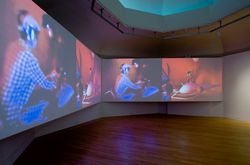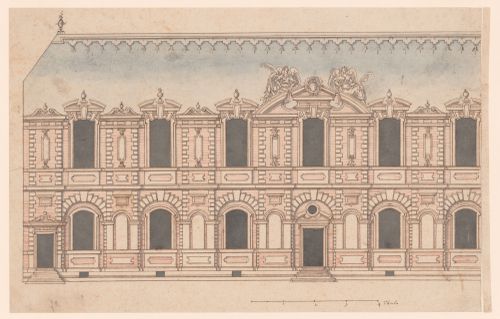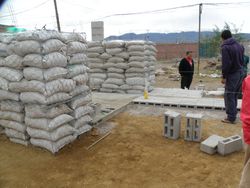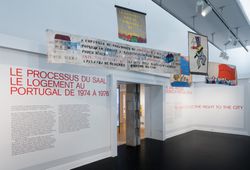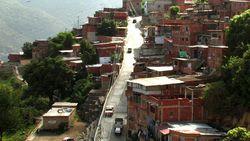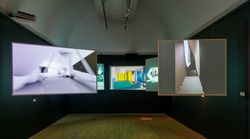“Today everything is environment,” proclaimed a Montreal newspaper at the beginning of the 1970s. The word “environment” had dominated the discourses and practices of artists, architects, social activists and intellectuals during the previous decade. Visitors of Expo ‘67, the event that galvanized the world’s attention on Montreal, commented the phantasmagorical(...)
Octagonal gallery
19 March 2009 to 23 August 2009
Total Environment: Montréal, 1965-1975
Actions:
Description:
“Today everything is environment,” proclaimed a Montreal newspaper at the beginning of the 1970s. The word “environment” had dominated the discourses and practices of artists, architects, social activists and intellectuals during the previous decade. Visitors of Expo ‘67, the event that galvanized the world’s attention on Montreal, commented the phantasmagorical(...)
Octagonal gallery
events
Learning from... London
Kieran Long presents a story about the difficulty of describing a city in all its richness. London contains stories and meanings that are alive to its citizens, but apparently too difficult to talk about, too rich, and too messy to be allowed to affect those who decide how the city changes. The deafness of developers, politicians and architects to these narratives is so(...)
Paul Desmarais Theater
10 March 2011 , 7pm
Learning from... London
Actions:
Description:
Kieran Long presents a story about the difficulty of describing a city in all its richness. London contains stories and meanings that are alive to its citizens, but apparently too difficult to talk about, too rich, and too messy to be allowed to affect those who decide how the city changes. The deafness of developers, politicians and architects to these narratives is so(...)
events
10 March 2011
7pm
Paul Desmarais Theater
Learning from… São Paulo
Angelo Bucci, architect and professor at the University of São Paulo, Brazil, addresses the violence and changing environment of São Paulo in search of new urban forms. São Paulo’s urban violence can be understood as ruining the experience of the city and, as a result, the purpose of the architect’s work. The lecture examines São Paulo not as a static object, but as an(...)
22 April 2010
Learning from… São Paulo
Actions:
Description:
Angelo Bucci, architect and professor at the University of São Paulo, Brazil, addresses the violence and changing environment of São Paulo in search of new urban forms. São Paulo’s urban violence can be understood as ruining the experience of the city and, as a result, the purpose of the architect’s work. The lecture examines São Paulo not as a static object, but as an(...)
Elevation of a palace façade
DR1970:0003
Description:
This drawing shows an exterior of a residential building. The artist uses color to suggest the materials used in construction; blue-grey for the pitched slate roof, brown for masonry details and architectural sculpture, and red striations for brickwork. This combination of materials was common in early modern France, where a play on color and materiality enlivened the façades of well-known royal edifices including the chateaux of Fontainebleau and Saint-Germain-en-Laye. As with the construction technique that interwove stone with brick, the architectural style depicted in the drawing combines traditional French ideas about building with classicizing elements imported to France via Italian artists and architects as well as through printed translations of Vitruvius’s 'De architectura' and Sebastiano Serlio’s architectural treatise. The inclusion of masonry rustication and the decorative urns that punctuate the roofline suggest a knowledge of classicizing trends in architectural ornament and a familiarity with the œuvre of artists working in the circle of the first and second Écoles de Fontainebleau. The structure’s elongated form suggests a gallery and the organization of the façade borrows the combination of slightly protruding vertical bays and long horizontal registers that characterizes Pierre Lescot’s wing of the Louvre, a project that would have been well-known in court circles in the latter half of the sixteenth century. Similarly, the two winged allegorical figures flanking the central pediment are reminiscent of Jean Goujon’s sculptural additions to the Lescot wing. In the Canadian Centre for Architecture’s drawing both figures hold palms, but the artist omitted any further identifying attributes, perhaps – along with the empty niches – as an invitation for the patron to imagine his or her own thematic program for the project.
first quarter of the 16th century
Elevation of a palace façade
Actions:
DR1970:0003
Description:
This drawing shows an exterior of a residential building. The artist uses color to suggest the materials used in construction; blue-grey for the pitched slate roof, brown for masonry details and architectural sculpture, and red striations for brickwork. This combination of materials was common in early modern France, where a play on color and materiality enlivened the façades of well-known royal edifices including the chateaux of Fontainebleau and Saint-Germain-en-Laye. As with the construction technique that interwove stone with brick, the architectural style depicted in the drawing combines traditional French ideas about building with classicizing elements imported to France via Italian artists and architects as well as through printed translations of Vitruvius’s 'De architectura' and Sebastiano Serlio’s architectural treatise. The inclusion of masonry rustication and the decorative urns that punctuate the roofline suggest a knowledge of classicizing trends in architectural ornament and a familiarity with the œuvre of artists working in the circle of the first and second Écoles de Fontainebleau. The structure’s elongated form suggests a gallery and the organization of the façade borrows the combination of slightly protruding vertical bays and long horizontal registers that characterizes Pierre Lescot’s wing of the Louvre, a project that would have been well-known in court circles in the latter half of the sixteenth century. Similarly, the two winged allegorical figures flanking the central pediment are reminiscent of Jean Goujon’s sculptural additions to the Lescot wing. In the Canadian Centre for Architecture’s drawing both figures hold palms, but the artist omitted any further identifying attributes, perhaps – along with the empty niches – as an invitation for the patron to imagine his or her own thematic program for the project.
In 1973, following the strikes that beset the British construction industry during the early 1970s, Alistair McAlpine commissioned a design program for his construction company, Sir Robert McAlpine Sons, that aimed to increase production efficiency and improve labour relations. Cedric Price’s proposal took the format of a two-volume report and a Portable Enclosures(...)
9 February 2017 to 14 May 2017
What About Happiness on the Building Site?
Actions:
Description:
In 1973, following the strikes that beset the British construction industry during the early 1970s, Alistair McAlpine commissioned a design program for his construction company, Sir Robert McAlpine Sons, that aimed to increase production efficiency and improve labour relations. Cedric Price’s proposal took the format of a two-volume report and a Portable Enclosures(...)
Learning from... Mexico City
Arturo Ortiz Struck describes the boundaries of formal and legal building in the context of Mexico:“In order to build a critical view of the production of space and architecture in this environment, we should start from two fundamental premises. The first considers that spaces reflect who we are, and they express our cultural ways and how we unfold in everyday life. The(...)
Paul-Desmarais Theatre
10 May 2012 , 7pm
Learning from... Mexico City
Actions:
Description:
Arturo Ortiz Struck describes the boundaries of formal and legal building in the context of Mexico:“In order to build a critical view of the production of space and architecture in this environment, we should start from two fundamental premises. The first considers that spaces reflect who we are, and they express our cultural ways and how we unfold in everyday life. The(...)
Paul-Desmarais Theatre
Born out of the Portuguese revolution of 25 April 1974, the Serviço Ambulatório de Apoio Local (Local Ambulatory Support Service) was a pioneering architectural and political experiment designed to address extreme housing shortages and poor living conditions in Portuguese cities. There was not only one SAAL: its initiatives and results varied widely depending on complex(...)
Main galleries
12 May 2015 to 4 October 2015
The SAAL Process: Housing in Portugal 1974–76
Actions:
Description:
Born out of the Portuguese revolution of 25 April 1974, the Serviço Ambulatório de Apoio Local (Local Ambulatory Support Service) was a pioneering architectural and political experiment designed to address extreme housing shortages and poor living conditions in Portuguese cities. There was not only one SAAL: its initiatives and results varied widely depending on complex(...)
Main galleries
Learning from... Caracas
Venezuelan law allows for an entity called the consejo communal (communal council), which empowers citizens to initiate local development projects through neighbourhood-based elected councils. Dario Azzellini and Oliver Ressler’s film, Comuna under construction (2010), begins with the story of a poor hillside community in Caracas as its inhabitants decide whether they(...)
Paul-Desmarais Theatre
8 May 2014 , 6pm
Learning from... Caracas
Actions:
Description:
Venezuelan law allows for an entity called the consejo communal (communal council), which empowers citizens to initiate local development projects through neighbourhood-based elected councils. Dario Azzellini and Oliver Ressler’s film, Comuna under construction (2010), begins with the story of a poor hillside community in Caracas as its inhabitants decide whether they(...)
Paul-Desmarais Theatre
Archaeology of the Digital: Complexity and Convention is the third exhibition related to the development of a strategy for collecting and preserving digital archives at the CCA. The Archaeology of the Digital program comprises twenty-five projects for which digital materials are integral to an understanding of the design process. For projects included in the first two(...)
11 May 2016 to 16 October 2016
Archaeology of the Digital: Complexity and Convention
Actions:
Description:
Archaeology of the Digital: Complexity and Convention is the third exhibition related to the development of a strategy for collecting and preserving digital archives at the CCA. The Archaeology of the Digital program comprises twenty-five projects for which digital materials are integral to an understanding of the design process. For projects included in the first two(...)
books
L'immeuble en formation : genèse de l'habitat collectif et avatars intermédiaires / Christian Moley.
Description:
200 pages : illustrations ; 24 cm
Liège : Mardaga, ©1991.
L'immeuble en formation : genèse de l'habitat collectif et avatars intermédiaires / Christian Moley.
Actions:
Holdings:
Description:
200 pages : illustrations ; 24 cm
books
Liège : Mardaga, ©1991.
